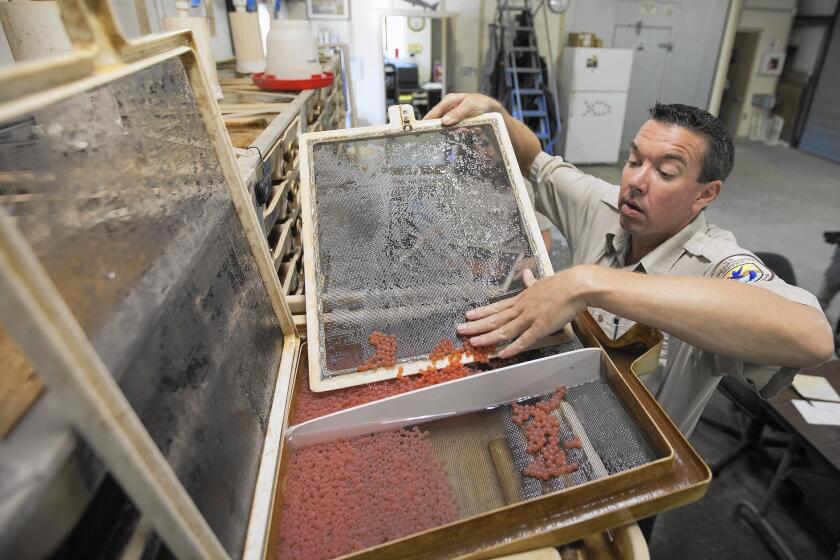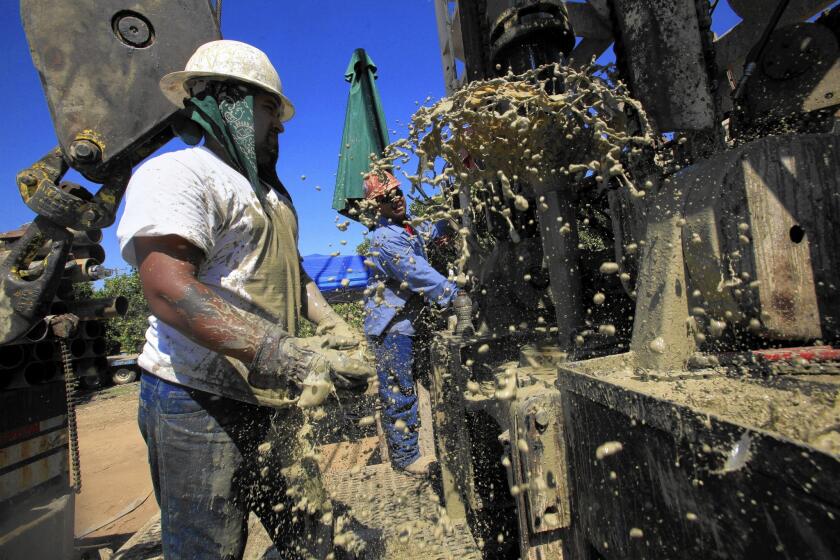Drought is back. But Southern California faces less pain than Northern California

- Share via
Drought is returning to California as a second, consecutive parched winter draws to a close in the usually wet north, leaving the state’s major reservoirs half empty.
But this latest period of prolonged dryness will probably play out very differently across this vast state.
In Northern California, areas dependent on local supplies, such as Sonoma County, could be the hardest-hit. Central Valley growers have been told of steep cuts to upcoming water deliveries. Environmentalists too are warning of grave harm to native fish.
Yet, hundreds of miles to the south, the Metropolitan Water District of Southern California reports record amounts of reserves — enough to carry the state’s most populous region through this year and even next.
Memories of unprecedented water-use restrictions in cities and towns, dry country wells and shriveled croplands linger from California’s punishing 2012-16 drought.
Officials say the lessons of those withering years have left the state in a somewhat better position to deal with its inevitable dry periods, and Gov. Gavin Newsom is not expected to declare a statewide drought emergency this year.
California’s largest reservoirs are storing anywhere between 38% and 68% of capacity.
“We don’t see ourselves in that position in terms of supply,” said Department of Water Resources Director Karla Nemeth. “If it’s dry next year, then maybe it’s a different story.”
Southern California is a case in point.
Lake Oroville, the big Sacramento Valley reservoir that helps supply the urban Southland, is only 41% full and the Metropolitan Water District can expect a mere 5% of full deliveries from the north this year.
But the agency has more water than ever stored in regional reservoirs and groundwater banks.
“We’re not contemplating any difficulty in meeting deliveries,” said Brad Coffey, water resources manager for the MWD, which imports supplies from the Colorado River and Northern California.
Los Angeles, which is partially supplied by the MWD, is similarly confident that it will have no problem meeting local demand. “We’re not in any shortage,” said Delon Kwan, assistant director of water resources for the L.A. Department of Water and Power.
L.A.’s water use has declined to 1970s levels, despite the fact that California’s biggest city has nearly 1 million more residents than it did then. Restrictions on landscape watering have been in place for a decade, and the city continues to offer conservation rebates for water-efficient appliances and lawn removal.
Across the state, overall urban water use remains 16% less than it was in 2013.
“We see an enduring conservation and efficiency from the last drought,” said E. Joaquin Esquivel, chairman of the State Water Resources Control Board. “We changed fundamentally our water use on the urban side.”
System improvements have been made in small rural communities that ran out of water when their wells dried up during the last drought.
Though agriculture is expected to once again turn to groundwater to make up for sharp cuts in federal irrigation deliveries, officials are hoping to avert a repeat of the last drought, when growers rushed to drill new wells and ramped up pumping so much that parts of the intensely farmed San Joaquin Valley sank several feet.
A simple instrument with a weight and a pulley confirmed what hydrologist Michelle Sneed had suspected after seeing more and more dirt vanish from the base of her equipment each time she returned to her research site last summer.
“I don’t fully expect the same scenario to play out,” said state Natural Resources Secretary Wade Crowfoot. “It was more of a free-for-all” before passage of a 2014 state law that requires groundwater users to stop chronic overpumping of the enormous Central Valley aquifer by 2040.
“My sense is that there’s a strong understanding among local water agencies that they now have a responsibility to achieve sustainability,” he added.
But environmentalists and the commercial salmon industry worry that this year will be a repeat of 2014-15, when low flows in the Sacramento River pushed water temperatures to lethally warm levels for salmon eggs, virtually wiping out two years of reproduction for endangered winter-run Chinook.
“Good for Metropolitan — they’ve got record storage,” said Barry Nelson of Western Water Strategies. “But the ecosystem and the fishing industry are cratering.”
Last summer, a narrow, rock-rimmed stretch of the Sacramento River near here turned into a mass graveyard for baby salmon.
Precipitation is only about half of average in key northern and central Sierra Nevada watersheds and 39% of average in the southern range. The statewide snowpack that helps fill reservoirs is well below average — 59% on Thursday — but not nearly as grim as 2014, when it was 33%, or the record low of 5% in 2015.
With Shasta Lake, the biggest reservoir in the federal Central Valley Project system, 53% full, the Bureau of Reclamation is significantly cutting supplies to many farmers in the San Joaquin Valley.
Growers on the west side of the valley are slated to get only 5% of their contract amounts, and even those deliveries have been temporarily frozen. On the east side, Millerton Lake deliveries have been reduced to 20% of contracted amounts.
But the cuts will be far less for irrigation districts with the oldest diversion rights on the Sacramento and San Joaquin rivers. Those senior rights holders can expect 75% of their contract amounts, which comes out to a total of 2.2 million acre-feet — more than four times what Los Angeles uses in a year.
Those huge contracts, which the bureau signed when the Central Valley Project dammed the Sacramento and San Joaquin, have long been attacked by the environmental community.
On a dusty clearing between a fallow wheat field and wilting orange groves, Steve Arthur’s crew of two mud-splattered well drillers worked furiously to deliver a lifeline to another despondent farmer.
In a March 12 letter to the state water board, environmental groups complained that releases from Shasta Lake for senior rights holders will deplete the reservoir of cold water needed later in the year to maintain salmon-friendly temperatures on the Sacramento River.
They also point out that meager precipitation is not the only reason Oroville, the State Water Project’s principal reservoir, is so low.
In 2018, the state and federal water projects amended a 30-year-old agreement that spelled out how they would coordinate operations to meet water quality and environmental standards in the Sacramento-San Joaquin Delta, a distribution hub for both projects.
Because Shasta’s capacity is considerably greater than Oroville’s, the original pact called for Shasta to provide the bulk of the releases necessary to meet delta standards. The 2018 agreement shifted some of the federal obligations to the state.
Especially in dry years, the state now has to release more water from Oroville to flow through the delta and out to sea than previously required. That has resulted in a corresponding reduction in state deliveries from the delta and an increase in federal deliveries.
The Water Resources Department did not provide numbers for this year. But in 2018, the agency estimated the new formula would reduce state deliveries by an average of 100,000 acre-feet a year, with that number increasing to 200,000 acre-feet in very dry years.
Nemeth acknowledged that the new operating terms have played a role in Oroville’s steep drop. But she attributed most of the decline to what she called “catastrophically dry” conditions in the Feather River watershed that feeds Oroville.
She also defended the 2018 deal, saying that in wet years it allows the state project to slightly increase delta exports to the MWD and other customers.
“It’s a trade-off,” said Doug Obegi, an environmental attorney with the Natural Resources Defense Council. “It’s not solving the problem that they’ve contracted more water than can be sustainably delivered.”
Two years ago, Shasta and Oroville were nearly full, thanks to 2019, the nation’s second-wettest year on record; and 2017, the wettest year on record in the northern Sierra.
That the levels of California’s two biggest reservoirs fell so quickly is another reminder of the effects of climate change, which is accentuating the swings from drought to flood that California has always experienced.
“Are we adapting enough? No,” Esquivel said. “We need to adapt further and faster and more. And we know that it takes dollars and resources to accomplish that work. It’s not any one thing. It’s investing in infrastructure … in water systems that will receive the brunt of the climate crisis.”












